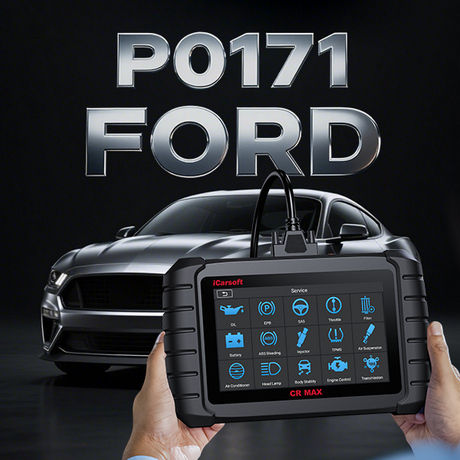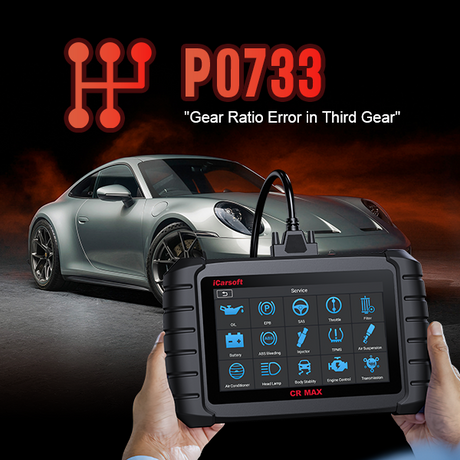Table of Contents
- 1. What Is a Camshaft Timing Error?
- 2. Symptoms of an Engine Timing Issue
- 3. Common Causes of Over-Retarded Timing Faults
- 4. How to Diagnose Camshaft Timing Problems
- 5. Steps to Fix Engine Timing Issues
- 6. How iCarsoft CR MAX and Eagle Assist
- 7. Cost Estimates for Resolving Timing Errors
- 8. Preventive Measures for Engine Timing Health
The P0012 error, also known as a camshaft timing error, occurs when the intake camshaft timing is delayed beyond its intended position. This issue can impact engine performance, fuel efficiency, and emissions in vehicles like the P0012 Ford F150, P0012 Ford, and P0012 Toyota. In this article, we’ll explore the symptoms, causes, and solutions for this diagnostic trouble code, and explain how tools like the iCarsoft CR MAX and CR Eagle can help resolve it efficiently. For related issues, check out our guides on P0011, P0013, and P0014.
1. What Is a Camshaft Timing Error?
The P0012 code is triggered when the Engine Control Module (ECM) detects that the intake camshaft position is too far behind its intended timing. This often happens due to issues with the variable valve timing systems (VVT), a technology that adjusts the timing of the intake valve to optimize engine performance. In vehicles like the P0012 Ford F150 or P0012 Toyota, this can lead to noticeable performance drops, increased emissions, and even engine misfire.

Note: P0012 indicates an over-retarded timing issue, meaning the camshaft is too delayed. In contrast, a P0011 code indicates over-advanced timing (too early), while P0014 and P0013 often relate to exhaust camshaft timing or circuit issues.
2. Symptoms of an Engine Timing Issue
When an engine timing issue occurs, you may notice several warning signs:
- A glowing check engine light on your dashboard
- Engine misfires or poor idling, causing the vehicle to shake
- Reduced engine performance and sluggish acceleration
- Lower fuel efficiency, leading to higher fuel costs
- Audible rattling noise or knocking sounds from the engine
- Difficulty starting the engine, especially in cold conditions
These symptoms can be particularly noticeable in models like the P0012 Ford, where the engine may struggle under varying engine load conditions. If ignored, severe cases can lead to an engine misfire, further damaging the engine.
3. Common Causes of Over-Retarded Timing Faults
Several factors can lead to an over-retarded timing fault. Here are the most common causes:
- A faulty camshaft position sensor providing incorrect data
- A worn or stretched timing belt or chain
- A clogged or stuck VVT actuator or control solenoid
- Low or contaminated engine oil, affecting oil pressure
- A malfunctioning oil control valve (OCV) regulating oil flow
- Wiring issues or poor electrical connections in the timing system
- An ECM or PCM malfunction disrupting advanced engine controls
In vehicles like the P0012 Toyota, low oil pressure due to neglected maintenance is a frequent culprit. For a P0012 Ford F150, a common issue might be a failing camshaft phaser, a component that adjusts camshaft timing in Ford’s VVT system.

4. How to Diagnose Camshaft Timing Problems
Diagnosing an engine timing issue requires a systematic approach. Here’s how a professional mechanic would proceed:
- Use an OBD-II scanner to read the trouble codes and confirm the issue.
- Inspect the camshaft position sensor and its wiring for damage or wear. For advanced diagnostics, use an oscilloscope to test the sensor’s waveform—it should show a consistent square wave; irregular patterns may indicate a faulty sensor.
- Check the timing belt or chain for signs of stretching or damage.
- Test the control solenoid and oil control valve (OCV) for proper function.
- Verify engine oil levels and quality, changing it if it’s dirty or low.
- Examine all related wiring and electrical components for faults.
For a P0012 Ford F150, checking the intake valve timing is crucial, as these models often face issues with the variable valve timing systems. In contrast, a P0012 Toyota might require more focus on oil pressure due to its VVT design.
5. Steps to Fix Engine Timing Issues
Once the cause is identified, follow these steps to resolve the camshaft timing error:
- Replace the camshaft position sensor if it’s faulty or damaged. For a visual guide, search online for videos like “How to replace a camshaft position sensor on a Ford F150.”
- Install a new timing belt or chain if it’s worn or stretched.
- Clean or replace the VVT actuator or control solenoid if it’s clogged or not working.
- Replace or clean the oil control valve (OCV) to restore proper oil flow.
- Top up or change the engine oil if it’s low or contaminated.
- Repair any damaged wiring or connections in the timing system.
In a P0012 Ford, replacing the oil control valve often resolves issues related to oil pressure and timing. For a P0012 Toyota, cleaning the VVT actuator might be a more common fix.
6. How iCarsoft CR MAX and Eagle Assist
The iCarsoft CR MAX and CR Eagle are powerful diagnostic tools that can help address trouble codes like this one. They offer the following features:
- Reading and clearing diagnostic trouble codes from the ECM
- Real-time data streaming of camshaft position sensors and timing system performance
- Advanced live data analysis of advanced engine timing and oil pressure. For example, you can use the CR MAX to check if the intake camshaft timing deviation exceeds ±5 degrees, indicating a potential issue with the VVT actuator.
- System testing for the intake camshaft, VVT components, and oil control valve
- Guided troubleshooting steps to quickly pinpoint the issue
For a P0012 Toyota, these tools can monitor the variable valve timing systems to ensure proper intake valve operation.

7. Cost Estimates for Resolving Timing Errors
The cost to fix an engine timing issue varies based on the root cause:
- Camshaft position sensor replacement: $150–$350
- Timing belt or chain replacement: $400–$1,200
- VVT actuator replacement: $100–$350
- Oil control valve replacement: $150–$300
- Engine oil change: $50–$150
- Total estimated cost: $200–$1,500
Costs may be higher for a P0012 Ford F150 due to labor rates and part availability for larger vehicles.
8. Preventive Measures for Engine Timing Health
To prevent future camshaft timing errors, follow these tips:
- Perform regular oil changes every 5,000 miles with high-quality engine oil (e.g., API-certified SN grade) to maintain oil pressure.
- Inspect and replace the timing belt or chain at manufacturer-recommended intervals, typically every 60,000 to 100,000 miles.
- Monitor engine performance and address rattling noise or poor idling promptly to avoid further damage.
- Ensure proper maintenance of camshaft position sensors and electrical components.
Tip: Regular maintenance can significantly improve fuel efficiency and prevent issues in vehicles like the P0012 Ford or P0012 Toyota. Always use the recommended oil viscosity for your vehicle, such as 5W-30 for most Ford F150 models.












